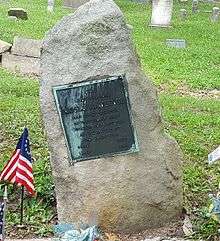Moses Rawlings
Moses Rawlings (1740–1809) served in the Continental Army during the American Revolutionary War, most notably at the Battle of Fort Washington. He attained the rank of lieutenant colonel before leaving the military in 1779. He later served as the State Commissioner for Prisoners in Maryland.
Moses Rawlings | |
|---|---|
 | |
| Born | 1745 Ann Arundel County, Maryland |
| Died | 1809 Hampshire County, Virginia (now West Virginia) |
| Buried | Rose Hill Cemetery, Cumberland, Maryland |
| Allegiance | |
| Service/ | Continental Army |
| Years of service | 1775 - 1779 |
| Rank | Continental Army
|
| Unit | Continental Army |
| Commands held | Continental Army |
| Battles/wars | American Revolutionary War |
| Other work | State Commissioner of Prisoners in Frederick Town, MD |
American Revolutionary War
Rawlings was appointed as first lieutenant in Capt. Michael Cresap's Independent Rifle Company from Frederick County, Maryland.[1] Shortly afterward Cresap died, and Rawlings replaced him as company commander. On June 17, 1776 the company was joined to the newly formed Maryland and Virginia Rifle Regiment and Rawlings was named second-in-command and promoted to the rank of lieutenant colonel. When the regimental commander, Col. Hugh Stephenson, died in August 1776 Rawlings took command of the regiment. The unit consisted of approximately 250 riflemen, and was often referred to as "Rawlings' Regiment".
During the Battle of Fort Washington the Maryland and Virginia Rifle Regiment was positioned about a half mile north of Fort Washington on Manhattan Island. From November 2 to November 14, 1776 they defended against German Hessian mercenaries, but on the 16th they were finally pushed back to Fort Washington, which surrendered a short time after.[2] Rawlings was taken prisoner, but escaped. General Washington had also requested that Rawlings be released as part of a prisoner exchange.[3]
Throughout the remainder of his military career, Rawlings often wrote to Washington concerning pay for his soldiers and recruits, as he had difficulty paying his soldiers. Washington's response often included requests that Rawlings use his own money to pay his soldiers until more money could be obtained from Congress.[4][5]
Post-War
In 1779 Rawlings became the State Commissioner of Prisoners out of Frederick Town, Maryland.[6][7]
Family
Rawlings was married to Elizabeth McMahon. He also had a son named Moses Rawlings.[8]
Notes
- Revolutionary Patriots of Anne Arundel County, Maryland, pp. 161
- Southern Campaign American Revolution Pension Statements
- George Washington to Joshua Loring (January 14, 1777)
- George Washington to William Palfrey (October 17, 1779)
- George Washington to Moses Rawlings (March 7, 1779)
- George Washington to Moses Rawlings (December 12, 1781)
- Rawlings Grave Marker (Grave marker). Rose Hill Cemetery, Cumberland, MD: Cumberland Historical Cemetery Organization. 2015.
- Revolutionary Patriots of Ann Arundel County, Maryland, pp. 161
References
- Dandridge, Danske (1911). American Prisoners of the Revolution, Charlottesville: The Michie Company, Printers.
- Heitman, Francis B. (1914). Historical register of officers of the Continental Army during the War of the Revolution, April, 1775, to December, 1783. Washington, D.C.: The Rare Book Shop Publishing Co., pp. 459
- Pedan, Henry C. (2006). Revolutionary Patriots of Anne Arundel County, Maryland, Heritage Books.
- Southern Campaign American Revolution Pension Statements
- George Washington to Joshua Loring (January 14, 1777) Library of Congress, George Washington Papers, Series 3e.
- George Washington to Moses Rawlings (March 7, 1779) Library of Congress, George Washington Papers, Series 3b.
- George Washington to William Palfrey (October 17, 1779) Library of Congress, George Washington Papers, Series 3b.
- George Washington to Moses Rawlings (December 12, 1781) Library of Congress, George Washington Papers, Series 4.